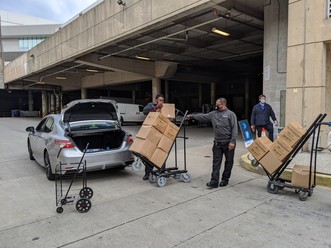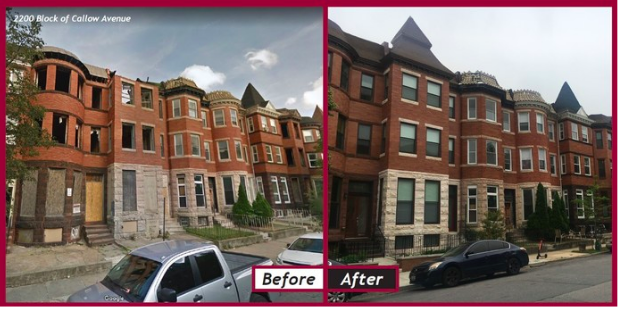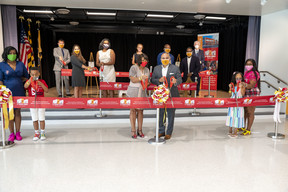In September, neighborhood canvassing in support of the 2020 Census has continued in neighborhoods across town.
The image below features Councilwoman Sneed; elected officials joined Census staff and volunteers to canvass in East Baltimore in mid-August. The young man behind Councilwoman Sneed is filling out the Census on one of the iPads acquired specifically for this outreach effort. Each canvassing event is making use of mobile technology to increase the participation rate in the most undercounted neighborhoods.
You may be wondering where we are in making progress towards our goal of having 73% of residents participate in the Census. Right now, we are at 54.5%. This means we have a lot of work to do this month and we need your help. Please help us by spreading the word - you can forward this newsletter via email, or mention the Census in your conversations with friends and family this week. Every person participating counts towards our goal.
Since early May, the Baltimore Convention Center (BCC) has played an important role in Baltimore City’s COVID-19 Emergency Food Response. The convention center is the City’s main food distribution center for grocery boxes and produce boxes delivered to resident homes through a partnership with Amazon Flex. To date, over 11,000 grocery boxes and 5,000 produce boxes have been delivered to homes through BCC. That is over 200 tons of food!
BCC has committed six staff members on a daily basis to operate the distribution center. They have provided 30,000 square feet for the distribution and storage of grocery boxes while also serving as a field hospital throughout the COVID-19 pandemic. This vital program serving food insecure Baltimore City residents would not be possible without the support of the Baltimore Convention Center and its dedicated team. Thank You!
 |

It is with a heavy heart that we share with you the passing of Mary Ellen Hayward in late July.
Mary Ellen was a museum curator, scholar, writer, and preservation activist whose work in Baltimore spans half a century. She produced three popular books on the architecture and development of Baltimore; placed at least a dozen neighborhoods on the National Register of Historic Places; and ceaselessly advocated for the preservation of Baltimore’s historic resources.
Her scholarship on the Baltimore rowhouse and the Alley house popularized Baltimore’s most ubiquitous historic resource. She helped all of us see the historic treasures in front of us, helped us understand and appreciate Baltimore’s built environment a little bit better, and galvanized Baltimoreans to come together and celebrate the great city in which we live.
Below is a list of her most notable books:
|
 In 2019, the Department of Planning hired PlaceEconomics to analyze the Baltimore City historic tax credit. The study is now available: An Analysis of the Baltimore Historic Preservation Tax Credit. Among its findings:
- More than 3,500 historic properties have been renovated using the tax credit, representing private sector investment of nearly $1.2 billion.
- The program creates jobs. Over the last five years an average of nearly 600 direct and indirect jobs, and $36 million in labor income have been generated each year through projects.
- The credit produces value. The properties whose credits have now expired increased in value from $17 million in 2000 to $211 million in 2019. Income from city property taxes on these properties rose from $1.3 million to $5.9 million.
Over the coming year, a tax credit advisory group will craft a bill focusing on enhancing the equity and effectiveness of the tax credit program. The group will focus on two areas in particular:
- Increasing the eligibility of the credit to encompass more neighborhoods of Baltimore, and
- Increasing the value of the credit in Baltimore’s more distressed neighborhoods.
We encourage interested parties to explore the document in its entirety. Any questions can be directed to Stacy Montgomery at stacy.montgomery@baltimorecity.gov

COVID-19 couldn’t stop the ribbon cutting celebration of Mary E. Rodman Elementary School, the latest school to be redeveloped as part of the 21st Century Schools construction program.
Even though the in-person festivities were limited, the excitement was not. Watch a video of the celebration here and take a virtual tour (starting at 29:44 minutes in). The INSPIRE Draft Recommendation report for the area is expected to be released in September. Watch here for updates.
|
A bold, new mosaic made its debut in the Park Circle neighborhood of Park Heights this August. The public art transformed a concrete wall at the edge of a vacant lot on Park Heights Avenue into a vibrant community mosaic.
Pam Curtis, the Park Circle Community Association leader and a graduate of the Baltimore Planning Academy, was the visionary leader behind this project. Ms. Curtis worked closely with James Ashford, NW Community Planner, and Kim Knox, Greening Coordinator, on all the necessary approvals.
The mosaic was created by Herb Massie, a community artist, organizer, teacher, sculptor, and mosaic artist. He received the Sue Hess Maryland Arts Advocate of the Year Award in 2016, and you can read an interview with him from that time.
You can also read an interview with Pam Curtis and her work in the Park Heights community in the Afro, found here.

Baltimore's Office of Sustainability believes that you don’t have to be a climate scientist or city planner to create sustainability + resilience. Everyone has a story to tell about making Baltimore a stronger, fairer and safer place for all of us. The #EveryStoryCounts campaign demonstrates this message.
Torbin Green is Baltimore's next #EveryStoryCounts feature! Torbin started out as a classroom volunteer at the St. Francis Neighborhood Center in Baltimore's Reservoir Hill neighborhood six years ago. Today, he is the center's Operations & Program Director. When COVID-19 hit Baltimore in March, he came up with a plan to make sure that none of the children in the center's after-school program lacked the ability to learn. Through the close relationships with families they serve, staff quickly realized that even more support was needed to weather the crisis. Now, Torbin and his team are distributing hundreds of free boxes of produce each week, and he has become an advocate for fresh food access in West Baltimore.
You can read a complete interview with Tobin via this link.
|
The City of Baltimore is in the process of identifying nuisance flooding locations and developing a Nuisance Flood Plan, as mandated by the State of Maryland, House Bill 1427 (2019).
As part of this effort, please fill out this short survey and share your experiences with nuisance flooding in Baltimore. We also kindly ask you to review our Nuisance Flood Plan draft. We will be collecting public input through Sunday 9/20.
Additionally, we have a virtual public information session scheduled for Thursday 9/24 at 4pm to present the final draft of the plan. Please visit the Baltimore Office of Sustainability website for meeting details.
Nuisance flooding, also known as “sunny day flooding,” is defined as high tide flooding that causes disruptions to daily activities. It can occur with or without precipitation and is expected to increase in the coming years due to anticipated sea level rise, particularly in areas like Fells Point. Our Office of Sustainability is documenting the impacts of this type of flooding and identifying actions to mitigate this hazard.
|